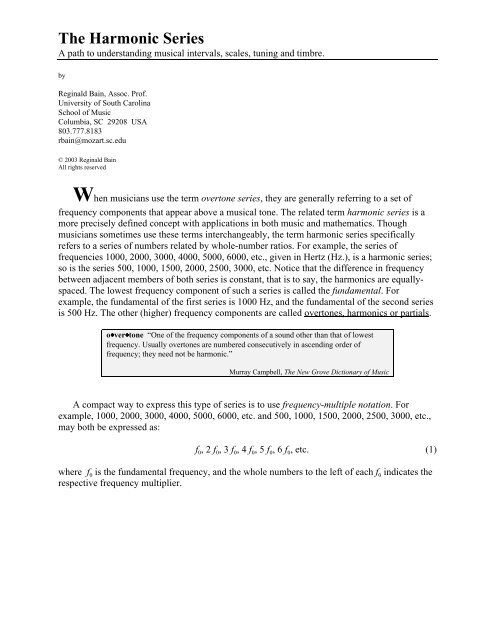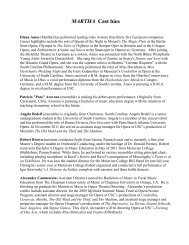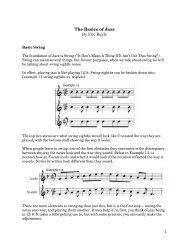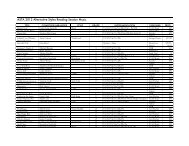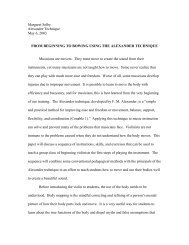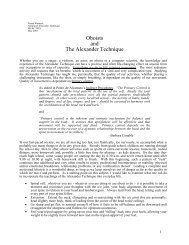The Harmonic Series - USC School of Music - University of South ...
The Harmonic Series - USC School of Music - University of South ...
The Harmonic Series - USC School of Music - University of South ...
Create successful ePaper yourself
Turn your PDF publications into a flip-book with our unique Google optimized e-Paper software.
<strong>The</strong> <strong>Harmonic</strong> <strong>Series</strong><br />
A path to understanding musical intervals, scales, tuning and timbre.<br />
by<br />
Reginald Bain, Assoc. Pr<strong>of</strong>.<br />
<strong>University</strong> <strong>of</strong> <strong>South</strong> Carolina<br />
<strong>School</strong> <strong>of</strong> <strong>Music</strong><br />
Columbia, SC 29208 USA<br />
803.777.8183<br />
rbain@mozart.sc.edu<br />
© 2003 Reginald Bain<br />
All rights reserved<br />
When musicians use the term overtone series, they are generally referring to a set <strong>of</strong><br />
frequency components that appear above a musical tone. <strong>The</strong> related term harmonic series is a<br />
more precisely defined concept with applications in both music and mathematics. Though<br />
musicians sometimes use these terms interchangeably, the term harmonic series specifically<br />
refers to a series <strong>of</strong> numbers related by whole-number ratios. For example, the series <strong>of</strong><br />
frequencies 1000, 2000, 3000, 4000, 5000, 6000, etc., given in Hertz (Hz.), is a harmonic series;<br />
so is the series 500, 1000, 1500, 2000, 2500, 3000, etc. Notice that the difference in frequency<br />
between adjacent members <strong>of</strong> both series is constant, that is to say, the harmonics are equallyspaced.<br />
<strong>The</strong> lowest frequency component <strong>of</strong> such a series is called the fundamental. For<br />
example, the fundamental <strong>of</strong> the first series is 1000 Hz, and the fundamental <strong>of</strong> the second series<br />
is 500 Hz. <strong>The</strong> other (higher) frequency components are called overtones, harmonics or partials.<br />
o•ver•tone “One <strong>of</strong> the frequency components <strong>of</strong> a sound other than that <strong>of</strong> lowest<br />
frequency. Usually overtones are numbered consecutively in ascending order <strong>of</strong><br />
frequency; they need not be harmonic.”<br />
Murray Campbell, <strong>The</strong> New Grove Dictionary <strong>of</strong> <strong>Music</strong><br />
A compact way to express this type <strong>of</strong> series is to use frequency-multiple notation. For<br />
example, 1000, 2000, 3000, 4000, 5000, 6000, etc. and 500, 1000, 1500, 2000, 2500, 3000, etc.,<br />
may both be expressed as:<br />
f 0, 2 f 0, 3 f 0, 4 f 0, 5 f 0, 6 f 0, etc. (1)<br />
where f 0 is the fundamental frequency, and the whole numbers to the left <strong>of</strong> each f 0 indicates the<br />
respective frequency multiplier.
<strong>The</strong> <strong>Harmonic</strong> <strong>Series</strong>: A path to understanding musical intervals, scales, tuning and timbre.<br />
by Reginald Bain<br />
A harmonic series may also be expressed using musical staff notation as shown in Fig. 1.<br />
<br />
1<br />
<br />
2<br />
<br />
3<br />
<br />
4<br />
<br />
5<br />
<br />
6<br />
- ♭<br />
7<br />
<br />
8<br />
<br />
9<br />
Fig. 1. <strong>The</strong> first 20 partials <strong>of</strong> a harmonic series for the fundamental pitch C2 (ca. 65.4 Hz.)<br />
expressed in traditional musical staff notation with frequency multiples indicated between the<br />
staves. <strong>The</strong> - and + symbols indicate that the notated pitch is significantly lower or higher,<br />
respectively, than the same pitch on a modern piano.<br />
<br />
10<br />
This traditional way <strong>of</strong> notating the harmonic series is obviously less precise at conveying<br />
frequency information than the frequency-multiple notation shown above in (1). However, it<br />
does provide a convenient way for musicians to memorize the harmonic series as a kind-<strong>of</strong><br />
chord/scale <strong>of</strong> nature. Once memorized it may easily be transposed to any fundamental pitch. For<br />
example, Fig. 2 shows a similar diagram for the first 20 partials <strong>of</strong> a harmonic series on A1 (ca.<br />
55 Hz.).<br />
<br />
<br />
1<br />
2<br />
<br />
3<br />
<br />
<br />
55 Hz.<br />
110 Hz.<br />
165 Hz.<br />
4<br />
<br />
220 Hz.<br />
275 Hz.<br />
♯ 5<br />
330 Hz.<br />
6<br />
385 Hz.<br />
-<br />
<br />
7<br />
440 Hz.<br />
<br />
8<br />
495 Hz.<br />
<br />
9<br />
550 Hz.<br />
♯<br />
10<br />
-<br />
-♯ <br />
11<br />
605 Hz.<br />
♯<br />
11<br />
Page - 2 -<br />
<br />
12<br />
660 Hz.<br />
<br />
12<br />
+<br />
♭<br />
13<br />
715 Hz.<br />
+ <br />
13<br />
-♭ 14<br />
770 Hz.<br />
-<br />
Fig. 2. <strong>The</strong> first 20 partials <strong>of</strong> a harmonic series for the fundamental pitch A1 (ca. 55 Hz.).<br />
In Fig. 2, the frequency <strong>of</strong> each partial has been also been specified. (<strong>The</strong> frequency <strong>of</strong> each<br />
partial may be calculated by multiplying the fundamental frequency, in this case 55 Hz., by the<br />
partial number indicated between the staves.) A simple explanation for why such a pattern <strong>of</strong><br />
harmonics (overtones) appears above the pitch we actually perceive may be found in the physical<br />
model <strong>of</strong> a plucked string. We will explore this model and the relationship between string length<br />
and music interval in the next section in order to gain a deeper understanding <strong>of</strong> why this pattern<br />
occurs in nature.<br />
Before we move on to the next section, it should be noted that composer Paul Hindemith’s<br />
book <strong>The</strong> Craft <strong>of</strong> <strong>Music</strong>al Composition (1942) contains one <strong>of</strong> the last century’s best known<br />
introductions to the role <strong>of</strong> the harmonic series in music. This article, inspired by Hindemith’s<br />
presentation (among others such as Cowell 1930), charts a similar course to the Hindemith.<br />
Interested readers looking for a more in depth discussion <strong>of</strong> these issues may wish to consider<br />
reading the Hindemith, as well as the other references listed at the end <strong>of</strong> the article.<br />
14<br />
♮<br />
15<br />
825 Hz.<br />
♯<br />
15<br />
<br />
16<br />
880 Hz.<br />
<br />
16<br />
♯<br />
17<br />
935 Hz.<br />
♯<br />
17<br />
<br />
18<br />
990 Hz.<br />
<br />
18<br />
♯<br />
19<br />
1045 Hz.<br />
♯<br />
19<br />
<br />
20<br />
1100 Hz.<br />
♯<br />
20
<strong>The</strong> <strong>Harmonic</strong> <strong>Series</strong>: A path to understanding musical intervals, scales, tuning and timbre.<br />
by Reginald Bain<br />
String Length and <strong>Music</strong>al Interval<br />
Fig. 3 shows an illustration <strong>of</strong> a monochord that appeared in Hindemith's book.<br />
Fig. 3. A monochord.<br />
A monochord is a simple instrument used by theorists since the Middle Ages to investigate the<br />
relationship between string length and pitch. A monochord has three main components: 1) a<br />
string fixed at both ends, 2) a moveable bridge, and 3) a resonating body. When plucked, the<br />
monochord's string vibrates at a rate directly proportional to its length. (<strong>The</strong> string’s density and<br />
tension must also be taken into account, but for the sake <strong>of</strong> simplicity let's leave those variables<br />
aside for now.) However, it has been demonstrated experimentally that this is not the only mode<br />
<strong>of</strong> vibration <strong>of</strong> the string. In addition to vibrating over its entire length, a string simultaneously<br />
vibrates over fractional divisions <strong>of</strong> its length (1/2, 1/3, 1/4, 1/5, 1/6, etc.; See also, Fig. 4)<br />
producing a series <strong>of</strong> harmonics (overtones) whose frequencies are inversely proportional (2x,<br />
3x, 4x, 5x, 6x, etc., where x is the fundamental frequency <strong>of</strong> the string) to those fractional<br />
divisions. <strong>The</strong>oretically an infinite number <strong>of</strong> these multiple modes <strong>of</strong> vibration exist, each mode<br />
producing its own harmonic. As one ascends the series, the amplitude, or loudness <strong>of</strong> each<br />
harmonic tends to diminish, so the higher modes produce harmonics that are usually too s<strong>of</strong>t for<br />
us to hear.<br />
Fig. 4. <strong>The</strong> first three simultaneous modes <strong>of</strong> vibration <strong>of</strong> a string whose length is L (not to scale).<br />
Research by music psychologists has shown that the ear/brain system tends to fuse<br />
harmonically-related frequency components into a single sensation we call pitch. So that rather<br />
than perceiving the many individual harmonics <strong>of</strong> a musical tone, we ordinarily perceive an<br />
identifiable tone color, or timbre, whose pitch is associated with the fundamental <strong>of</strong> the harmonic<br />
series being experienced.<br />
“…pitch is the intersubjective correlate <strong>of</strong> frequency.”<br />
Page - 3 -<br />
Robert Morris, Composition with Pitch-Classes
<strong>The</strong> <strong>Harmonic</strong> <strong>Series</strong>: A path to understanding musical intervals, scales, tuning and timbre.<br />
by Reginald Bain<br />
It should be noted that a series <strong>of</strong> frequency components that are nearly harmonically-related,<br />
such as,<br />
f 0, 2.01 f 0, 3.05 f 0, 3.99 f 0, 4.98 f 0, 6.02 f 0, etc.<br />
also produces a sensation <strong>of</strong> pitch. <strong>The</strong> process by which the brain tends to fuse individual pure<br />
tone, or sinusoidal, components together to form a single pitch sensation is called fusion. A<br />
stunning fact uncovered by music psychologists doing research on fusion in the 1920’s was that<br />
the omission <strong>of</strong> the fundamental frequency from a series <strong>of</strong> harmonically-related components<br />
does not change our sensation <strong>of</strong> pitch. Fusion is but one example <strong>of</strong> the link that exists between<br />
the harmonic series and our perception the timbre <strong>of</strong> a particular instrument. We will explore the<br />
issue <strong>of</strong> timbre further near the end <strong>of</strong> this article.<br />
<strong>The</strong> Path to Just Intervals<br />
<strong>The</strong> discovery <strong>of</strong> a numerical relationship between string length and musical interval is<br />
commonly attributed to the Greek philosopher and theorist Pythagoras (c. 550 BCE). Returning<br />
to the plucked string model discussed in the previous section, we say that the pitch produced by a<br />
string <strong>of</strong> length L/2 sounds an octave higher than the pitch produced by a string <strong>of</strong> length L.<br />
(Again, please keep in mind that for two different strings, both strings must have the same<br />
density and tension for this to be the case.) This relationship between string length and musical<br />
interval provides musicians with a precise way to express the size <strong>of</strong> a musical interval. For<br />
example, let’s divide a string into two equal parts, a string length division ratio <strong>of</strong> 1:2. When we<br />
pluck each 1:2 division, or string segment, a pitch related by an octave (i.e., the interval whose<br />
frequency is 2:1) will sound. Say we divide a string into three equal parts and pluck each <strong>of</strong> those<br />
segments. Each segment will produce a pitch three times that <strong>of</strong> the original or a perfect twelfth<br />
higher (i.e., the interval whose frequency ratio is 3:1). Fig. 5 shows another diagram from<br />
Hindemith’s <strong>The</strong> Craft <strong>of</strong> My <strong>Music</strong>al Composition. It was designed to illustrate three basic<br />
string divisions (1:1, 1:2 and 1:3) and the pitches that will be produced when each segment is<br />
plucked.<br />
Fig. 5. String length division diagram from Hindemith’s <strong>The</strong> Craft <strong>of</strong> My <strong>Music</strong>al Composition.<br />
String length ratios and interval frequency ratios are usually expressed in their simplest form,<br />
and may alternatively be written using a division symbol ‘/’ in place <strong>of</strong> the ratio ‘:’ symbol. For<br />
example, the interval whose frequency ratio is 6:4, would normally be simplified to 3:2, which<br />
may also be written 3/2. Finally, it should be stated that string lengths and interval frequency<br />
Page - 4 -
<strong>The</strong> <strong>Harmonic</strong> <strong>Series</strong>: A path to understanding musical intervals, scales, tuning and timbre.<br />
by Reginald Bain<br />
ratios exhibit a reciprocal relationship, that is, the top and bottom numbers involved in the<br />
fractions switch places.<br />
Because <strong>of</strong> their association with the intervals found in a harmonic series, intervals such as<br />
2:1, 3:1, 3:2, 4:3, 5:3 are <strong>of</strong>ten called natural intervals. What is more, Fig. 1 can be used to look<br />
up which natural interval frequency ratio corresponds to which traditional tonal interval name<br />
(major third, minor third, perfect fifth, etc.), providing a convenient reference for musicians. For<br />
example, let's look up the natural interval frequency ratio for a perfect fifth. To do this, search<br />
Fig. 1 from left-to-right, looking for the first perfect fifth you encounter between any two<br />
members <strong>of</strong> the series. Notice that a perfect fifth is formed by the second and third members <strong>of</strong><br />
the series. Consequently, the natural interval frequency ratio for the perfect fifth can be<br />
expressed as 3:2. Confirm this finding by searching for another perfect fifth higher up the series.<br />
Verify that the perfect fifth you find can be simplified to the ratio 3:2. <strong>The</strong> frequency-multiple<br />
numbers between the staves in Fig. 1 can be used to determine the interval frequency ratio for<br />
any natural interval. Since the term natural interval frequency ratio is quite a mouthful,<br />
composers and theorists more commonly refer to such intervals as just intervals. To gain a<br />
deeper understanding <strong>of</strong> the correspondence between traditional tonal interval names and just<br />
interval ratios, use Fig. 1 now to look up the traditional tonal intervals listed in Fig. 6a.<br />
a. perfect fifth, b. perfect fourth, c. major sixth, d. major third, e. minor third<br />
f. minor sixth, g. minor seventh, h. major second, i. major seventh, j. minor second<br />
Fig. 6a. Common traditional tonal interval names.<br />
You will find these intervals to be equivalent to the following just ratios, respectively:<br />
a. 3:2, b. 4:3, c. 5:3, d. 5:4, e. 6:5<br />
f. 8:5, g. 9:5, h. 9:8, i. 15:8, j. 16:15<br />
Fig. 6b. Just ratios corresponding to the<br />
traditional tonal interval names shown in Fig. 6a<br />
Notice how all <strong>of</strong> the numbers involved in the ratios shown in Fig. 6b are either a multiple <strong>of</strong> 2,<br />
or a multiple <strong>of</strong> a prime number not greater than 5. As such, these ratios are said to be members<br />
<strong>of</strong> a just 5-limit tuning system. In his book Genesis <strong>of</strong> a <strong>Music</strong> (1949), composer Harry Partch<br />
assigned names to these and many other just intervals found in the lower reaches <strong>of</strong> the harmonic<br />
series. Click here to go to a page where you can hear these intervals, as well as learn the names<br />
Partch assigned them. As you can see, it is definitely worth one’s time to memorize the harmonic<br />
series on a fundamental <strong>of</strong> C2 up to the sixteenth partial as shown in Fig. 1. Once memorized on<br />
C2, this pattern may easily be transposed to any other fundamental pitch.<br />
On the horns <strong>of</strong> dilemma<br />
“On the whole <strong>of</strong> the historical period <strong>of</strong> instrumental music, Western music has based<br />
itself upon an acoutical lie. In our time this lie--that the normal musical ear hears<br />
twelve equal intervals within the span <strong>of</strong> an octave--has led to the impoverishment <strong>of</strong><br />
pitch usage in our music.”<br />
Ben Johnston, Program Notes for his Fourth String Quartet<br />
Page - 5 -
<strong>The</strong> <strong>Harmonic</strong> <strong>Series</strong>: A path to understanding musical intervals, scales, tuning and timbre.<br />
by Reginald Bain<br />
<strong>The</strong> Path to Scales and Tuning Systems<br />
Imagine a melody that employs only octave-related pitches. How boring. Clearly, the ear<br />
perceives the octave to be a very large intervallic distance. Other, smaller intervals are obviously<br />
required if we are to achieve a greater degree <strong>of</strong> melodic expressiveness. Many cultures,<br />
including our own, have gone so far as to assume that pitches related by a 2:1 frequency ratio<br />
should be considered equivalent. This important musical principle, known as octave equivalence,<br />
lies at the very foundation <strong>of</strong> tuning theory. But exactly how does one go about dividing up the<br />
octave to create a scale? As it turns out, this is a rather complex question, so we will attempt<br />
here to present only the most basic principles. Our goal will be to provide you with some insight<br />
into the relationship that exists between the harmonic series and the seven-tone diatonic scale,<br />
perhaps the most important scale in Western music.<br />
<strong>The</strong> word scale was derived from the Greek word, skala, meaning steps. <strong>The</strong> process <strong>of</strong><br />
creating a scale may conveniently be thought <strong>of</strong> as dividing the octave (or other basic interval<br />
such as 3:1) into discrete steps. <strong>The</strong> size <strong>of</strong> each step is chosen to achieve a specific musical goal.<br />
Sometimes the goal is melodic in nature, other times it is harmonic, or perhaps it is some other<br />
musical goal established by a composer or instrument maker. <strong>The</strong> important thing to remember is<br />
that the size <strong>of</strong> the intervals that make up a given scale may be determined in a variety <strong>of</strong> ways.<br />
For example, the diatonic scale has been tuned in a variety <strong>of</strong> ways throughout history. During<br />
the Middle Ages (c476-1453) a Pythagorean tuning, a tuning derived from a series <strong>of</strong> six 3:2<br />
fifths, was an accepted “standard” for tuning the seven tones <strong>of</strong> a diatonic scale. In the<br />
Renaissance (c1450-1600), however, a just tuning derived from the frequency relationships<br />
found in the first sixteen partials <strong>of</strong> the harmonic series emerged to rival Pythagorean tuning.<br />
Soon afterward a mean-tone temperament and a variety <strong>of</strong> other competing temperaments like<br />
Werkmeister and twelve-tone equal temperament were proposed. Each <strong>of</strong> these tuning systems<br />
<strong>of</strong>fers its own set <strong>of</strong> benefits, as well as introduces new musical problems, so it is up to<br />
musicians to decide which system works best for a particular music.<br />
J. Murray Barbor in his book Tuning and Temperament: A Historical Survey (1953),<br />
conveniently divides all tuning systems into two general categories:<br />
1. Tunings - scale tones are derived from the harmonic series (i.e., whole-number ratios)<br />
2. Temperaments - scale tones are derived by making adjustments to a tuning in order to achieve a desired<br />
musical result<br />
Our currently accepted standard for tuning fixed-pitch instruments, twelve-tone equal<br />
temperament (12TET), emerged as a competitor in the early eighteenth century. (It should<br />
probably mentioned here that an equal division <strong>of</strong> the tone was suggested as early as the Greek<br />
philosopher/theorist Aristoxenus, b. c375-360 BCE.) Twelve-tone equal temperament was<br />
introduced as a solution to the problem that certain intervals did not remain the same size after<br />
modulation. Perhaps the best way to learn more about tuning theory is to do the math for<br />
yourself, performing the calculations necessary to derive a 7-tone diatonic and 12-tone chromatic<br />
scale in a given tuning system.<br />
Page - 6 -
<strong>The</strong> <strong>Harmonic</strong> <strong>Series</strong>: A path to understanding musical intervals, scales, tuning and timbre.<br />
by Reginald Bain<br />
Click on a link to learn more about one <strong>of</strong> the following tuning systems:<br />
1. Pythagorean tuning - a tuning based on the line <strong>of</strong> fifths<br />
2. Just tuning - a tuning based on the intervals found in the lower part <strong>of</strong> the harmonic series<br />
3. Mean-tone temperament - a temperament derived by making an adjustment to a just tuning<br />
4. Twelve-tone equal temperament (12TET) - an accepted standard for tuning fixed-pitched instruments<br />
(such as the piano) since the time <strong>of</strong> J.S. Bach<br />
On recognizable diatonic tunings<br />
“<strong>The</strong> structure <strong>of</strong> recognizable diatonic tunings is basically an array <strong>of</strong> intricate<br />
interconnections...which are the very foundation <strong>of</strong> what is perceived as tonal<br />
harmonic motion, are shaped by the short-term span <strong>of</strong> human memory, the tolerance<br />
range <strong>of</strong> the human ear, and the peculiar manner in which intervals are perceived.”<br />
Easley Blackwood, <strong>The</strong> Structure <strong>of</strong> Recognizable Diatonic Tunings<br />
<strong>The</strong> Path to Consonance and Dissonance<br />
<strong>The</strong> nineteenth-century physicist Herman von Helmholtz proposed a theory <strong>of</strong> consonance<br />
and dissonance based on the harmonic series, beating, and what he termed roughness. When two<br />
pure tones are very close in frequency (e.g., 440 and 442 Hz.) we perceive a regular variation in<br />
loudness, or amplitude, <strong>of</strong> the complex tone they combine to produce called beats. <strong>The</strong><br />
phenomenon <strong>of</strong> beating is used by musicians every day in the tuning <strong>of</strong> their instruments.<br />
Though perhaps a gross oversimplification <strong>of</strong> the actual physical model, it is convenient to think<br />
<strong>of</strong> all musical tones as consisting <strong>of</strong> a series <strong>of</strong> harmonically-related pure tone components above<br />
the fundamental pitch we perceive. Additionally, recall that these pure tone components diminish<br />
significantly in loudness as one ascends the harmonic series. Furthermore, recent studies by<br />
music psychologists suggest that only the first six pure tone components contribute significantly<br />
to our classification <strong>of</strong> intervals as either consonant or dissonant (Campbell and Greated 1980).<br />
Though Helmholtz’s theory is now considered to be too simplistic from the point <strong>of</strong> view <strong>of</strong><br />
modern physics and music psychology, it is still worthy <strong>of</strong> our study because it provides a means<br />
<strong>of</strong> understanding the relationship between the harmonic series and the common “harmonious<br />
intervals”. Since the time <strong>of</strong> Pythagoras, many cultures have noted that frequency ratios<br />
involving relatively small integers such as 1:1, 2:1, 3:2, 4:3, 5:3, 5:4, and 6:5 produce the<br />
common harmonious, stable or consonant intervals in music. Helmholtz proposed that the degree<br />
<strong>of</strong> dissonance produced by an interval is related to the degree <strong>of</strong> roughness produced by partials<br />
<strong>of</strong> the two fundamental tones that make up the interval. <strong>The</strong> term roughness was a quality<br />
Helmholtz associated with the number <strong>of</strong> semitone and whole-tone conflicts among the partials<br />
<strong>of</strong> the two fundamental tones. It should be stated, however, that the term roughness has an<br />
entirely different meaning in modern acoustics/psychoacoustics (See Beats, Critical Band, and<br />
Roughness for more information). Fig. 7 shows the partial conflicts for nine common intervals:<br />
&<br />
?<br />
w<br />
2:1<br />
w<br />
w w<br />
w<br />
3:2<br />
w<br />
w w<br />
w<br />
4:3<br />
w<br />
w w<br />
w<br />
5:4<br />
# w<br />
w w<br />
w<br />
Page - 7 -<br />
5:3<br />
# w<br />
w w<br />
w<br />
b<br />
b w<br />
bw<br />
b w<br />
w bw<br />
6:5<br />
w<br />
b<br />
b w<br />
bw<br />
b w<br />
w w b<br />
Fig. 7. Helmholtz degree <strong>of</strong> dissonance diagram after Campbell and Greated 1987.<br />
8:5<br />
w<br />
9:8<br />
# w<br />
w w<br />
w<br />
b<br />
b w<br />
bw<br />
b w<br />
w bw<br />
16:15
<strong>The</strong> <strong>Harmonic</strong> <strong>Series</strong>: A path to understanding musical intervals, scales, tuning and timbre.<br />
by Reginald Bain<br />
Fundamental tones are notated in the bass clef staff. <strong>The</strong> first six partials <strong>of</strong> each fundamental<br />
tone are shown in the treble clef staff using smaller noteheads. Semitone conflicts between<br />
partials are indicated using a solid line. Whole-tone conflicts are indicated using a dotted line. It<br />
was assumed by Helmholtz that a semitone conflict was perceived to be more dissonant than a<br />
whole-tone conflict. For each interval shown in Fig. 7, compare the number <strong>of</strong> semitone and<br />
whole-tone conflicts that occur between partials. You will find that the interval 16:15 seems to<br />
produce the most roughness, followed by 9:8, 8:5, and so on. It should also be mentioned that<br />
modern music psychologists make a distinction between sensory consonance/dissonance and<br />
musical consonance/dissonance, and have also demonstrated that factors such as register and<br />
dynamic level play a large role in how we actually perceive the relative consonance or<br />
dissonance <strong>of</strong> musical intervals. Though there is much more to the principle <strong>of</strong> consonance and<br />
dissonance in music, Helmholtz’s degree <strong>of</strong> dissonance theory nonetheless provides us with<br />
some insight into the harmonic series’s role in our perception <strong>of</strong> musical intervals. Before we<br />
leave Fig. 7., use Helmholtz’s degree <strong>of</strong> dissonance model to rank the nine intervals shown from<br />
most consonant to most dissonant. Did you come up with a different order than the order shown<br />
in Fig. 7?<br />
<strong>The</strong> Path to Timbre<br />
In the 1970’s John Grey, James A. Moorer, and J. C. Risset were some <strong>of</strong> the first<br />
musicians/scientists to use computers to analyze tones produced by acoustic instruments. Using<br />
computers they were able to isolate the individual partials <strong>of</strong> a variety <strong>of</strong> acoustic instrument<br />
tones and show how each partial's amplitude progressed independently through time. Fig. 8<br />
displays an analysis <strong>of</strong> a trumpet tone produced by Grey and Moorer.<br />
Fig. 8. <strong>The</strong> amplitude progressions <strong>of</strong> the partials <strong>of</strong> a trumpet tone.<br />
Page - 8 -
<strong>The</strong> <strong>Harmonic</strong> <strong>Series</strong>: A path to understanding musical intervals, scales, tuning and timbre.<br />
by Reginald Bain<br />
<strong>The</strong> graph in Fig. 8 is 3-dimensional. <strong>The</strong> three dimensions are: 1) time, read left-to-right, 2)<br />
amplitude, read down-to-up, and 3) partial number, read back-to-front. This type <strong>of</strong> diagram is<br />
called a spectral diagram because it unveils the frequency components <strong>of</strong> the acoustical sound<br />
source. Recall that when light is passed through a prism, the individual frequency component<br />
(colors) <strong>of</strong> white light are unveiled because they travel at different speeds through the glass<br />
medium. Similarly, Fig. 8 shows the first twelve partials <strong>of</strong> a trumpet tone. <strong>The</strong> first .5 seconds<br />
<strong>of</strong> the trumpet tone are displayed. Notice how the lower partials rise first. Also notice how the<br />
lowest tone components are both the loudest and the last to decay. From this analysis we can see<br />
that the basic building blocks <strong>of</strong> a trumpet tone can be expressed as harmonic partials (or perhaps<br />
more accurately, nearly-harmonic partials). In 1822, the French mathematician Jean Baptist<br />
Fourier (1768-1830) came forth with a mathematical pro<strong>of</strong> demonstrating that any waveform or<br />
signal, no matter how complex, could be reduced to an infinite set <strong>of</strong> sine wave components.<br />
This type <strong>of</strong> analysis is called Fourier analysis. Most musical instruments produce waveforms<br />
that have been found to be periodic or quasi-periodic, meaning that a basic waveshape is<br />
repeated over-and-over throughout the course <strong>of</strong> the tone. Fourier analysis can be implemented<br />
on modern personal computers using a computationally intensive algorithm known as the Fast-<br />
Fourier Transform (FFT). FFT algorithms can run on today’s fast personal computers in realtime,<br />
opening up myriad possibilities for application in the music industry as demonstrated by<br />
FFT algorithm’s use in MP3 and other compression techniques.<br />
On the human auditory system<br />
“…periodic is a term frequently used by scientists and engineers to describe a large<br />
class <strong>of</strong> signals whose component parts fall in the harmonic series, but in fact signals<br />
in nature are not periodic, and the human auditory system knows this to be so.”<br />
John Chowning, Perceptual Fusion and Auditory Perspective<br />
References<br />
Barbour, J. Murray. Tuning and Temperament: A Historical Survey. East Lansing: Michigan State College Press,<br />
1967.<br />
Campbell, Murray and Clive Greated. <strong>The</strong> <strong>Music</strong>ian’s Guide to Acoustics. New York: Schirmer, 1987, pp. 84-86<br />
and 165-167.<br />
Chowning, John. “Perceptual Fusion and Auditory Perspective.” In Cook, Perry, <strong>Music</strong> Cognition and Computerized<br />
Sound. Cambridge, MA: MIT Press, 1999, pp. 261-275.<br />
Cowell, Henry. New <strong>Music</strong>al Resources. Cambridge: Cambridge <strong>University</strong> Press, 1996.<br />
Hindemith, Paul. <strong>The</strong> Craft <strong>of</strong> <strong>Music</strong>al Composition, Book 1: <strong>The</strong>ory, Fourth Edition. New York: Schott, 1970.<br />
Johnston, Ben. “Program Notes for Fourth String Quartet, <strong>University</strong> <strong>of</strong> Wisconson, Milwaukee, April 28. 1974.” In<br />
Cope, David, New Directions in <strong>Music</strong>, Prospect Heights, IL: Waveland, 2001, p. 70.<br />
Moorer, J. A. and Grey, J.M. “Lexicon <strong>of</strong> Analyzed Tones (Part 3: <strong>The</strong> Trumpet).” Computer <strong>Music</strong> Journal, 1(3),<br />
1977, pp. 12-29.<br />
Morris, Robert. Composition with Pitch-Classes. New Haven: Yale <strong>University</strong> Press, 1987.<br />
Partch, Harry. Genesis <strong>of</strong> a <strong>Music</strong>, Second Edition. New York: Da Capo Press, 1974, pp. 68-69.<br />
<strong>The</strong> New Grove Dictionary <strong>of</strong> <strong>Music</strong> – www.grovemusic.com.<br />
Page - 9 -


